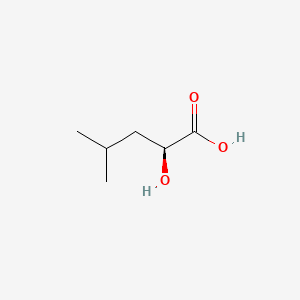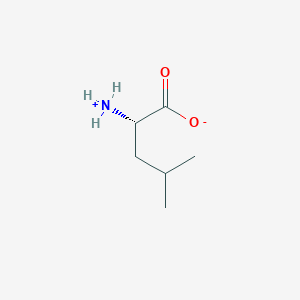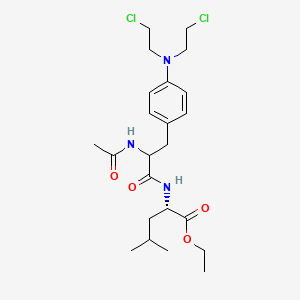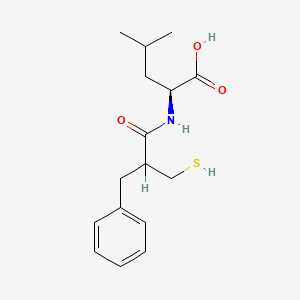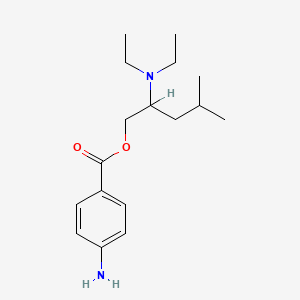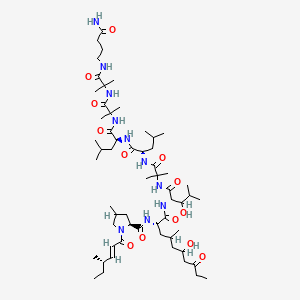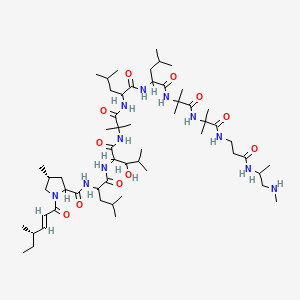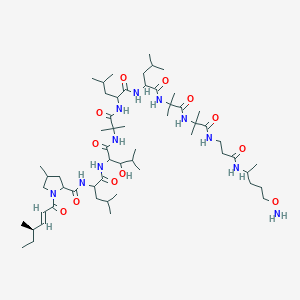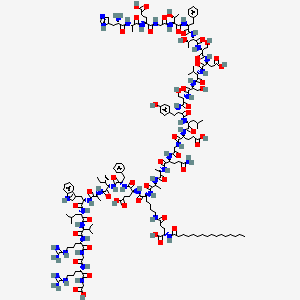
Liraglutida
Descripción general
Descripción
La liraglutida es un análogo sintético del péptido similar al glucagón 1 humano, que se utiliza principalmente en el tratamiento de la diabetes mellitus tipo 2 y la obesidad . Se comercializa bajo los nombres comerciales Victoza y Saxenda . La this compound imita la acción de la hormona natural péptido similar al glucagón 1, que ayuda a regular los niveles de azúcar en la sangre y el apetito .
Mecanismo De Acción
La liraglutida ejerce sus efectos actuando como un agonista del receptor del péptido similar al glucagón 1 . Este receptor participa en la regulación de la secreción de insulina, la liberación de glucagón y el apetito . Al activar este receptor, la this compound aumenta la secreción de insulina, inhibe la liberación de glucagón, ralentiza el vaciado gástrico y reduce la ingesta de alimentos .
Aplicaciones Científicas De Investigación
La liraglutida tiene una amplia gama de aplicaciones de investigación científica:
Química: Se utiliza como péptido modelo para estudiar técnicas de síntesis y modificación de péptidos.
Biología: Se investiga su papel en la regulación del metabolismo de la glucosa y el apetito.
Medicina: Se estudia ampliamente sus efectos terapéuticos en la diabetes tipo 2 y la obesidad.
Industria: Se utiliza en el desarrollo de nuevos productos terapéuticos basados en péptidos.
Análisis Bioquímico
Biochemical Properties
Liraglutide plays a significant role in biochemical reactions. It interacts with various enzymes, proteins, and other biomolecules. For instance, it has been found to interact with glucagon-like peptide 1 receptor (GLP-1R), which is a G protein-coupled receptor . The nature of these interactions involves binding to the receptor, which triggers a series of biochemical reactions leading to the secretion of insulin .
Cellular Effects
Liraglutide has profound effects on various types of cells and cellular processes. It influences cell function by impacting cell signaling pathways, gene expression, and cellular metabolism. For instance, it has been found to preserve pancreatic beta cells via regulation of cell kinetics and suppression of oxidative and endoplasmic reticulum stress in a mouse model of diabetes .
Molecular Mechanism
The mechanism of action of Liraglutide is quite complex. It exerts its effects at the molecular level through binding interactions with biomolecules, enzyme inhibition or activation, and changes in gene expression. For instance, it binds to the GLP-1R, which leads to the activation of adenylyl cyclase and an increase in cyclic AMP levels .
Temporal Effects in Laboratory Settings
In laboratory settings, the effects of Liraglutide change over time. It has been found to have a half-life of more than 13 hours, indicating its stability . Long-term effects on cellular function observed in in vitro or in vivo studies include improved insulin sensitivity and glucose homeostasis .
Dosage Effects in Animal Models
The effects of Liraglutide vary with different dosages in animal models. For instance, in db/db mice, Liraglutide treatment improved metabolic variables and insulin sensitivity .
Metabolic Pathways
Liraglutide is involved in several metabolic pathways. It interacts with enzymes such as adenylyl cyclase and influences metabolic flux and metabolite levels .
Transport and Distribution
Liraglutide is transported and distributed within cells and tissues. It is administered as an isotonic solution by subcutaneous injection .
Subcellular Localization
Given its role in activating the GLP-1R, it is likely that it is localized to the cell membrane where this receptor is found .
Métodos De Preparación
Rutas Sintéticas y Condiciones de Reacción
La liraglutida se sintetiza uniendo un ácido graso C-16 (ácido palmítico) con un espaciador de ácido glutámico al residuo de lisina en la posición 26 del precursor peptídico . La síntesis implica técnicas de síntesis de péptidos en fase sólida, donde los aminoácidos se añaden secuencialmente a una cadena peptídica creciente anclada a una resina sólida . El producto final se escinde entonces de la resina y se purifica mediante cromatografía líquida de alta eficacia .
Métodos de Producción Industrial
La producción industrial de this compound implica la síntesis de péptidos en fase sólida a gran escala seguida de la purificación mediante técnicas de cromatografía . El proceso se optimiza para garantizar un alto rendimiento y pureza del producto final, lo que es esencial para su eficacia terapéutica .
Análisis De Reacciones Químicas
Tipos de Reacciones
La liraglutida sufre varias reacciones químicas, entre ellas:
Reducción: Las reacciones de reducción son menos comunes, pero pueden producirse en condiciones específicas.
Reactivos y Condiciones Comunes
Oxidación: Se puede utilizar peróxido de hidrógeno u otros agentes oxidantes en condiciones controladas.
Reducción: Se pueden utilizar agentes reductores como el ditiotreitol.
Sustitución: Se pueden utilizar varios reactivos químicos para introducir sustituciones en residuos específicos.
Principales Productos Formados
Los principales productos formados a partir de estas reacciones incluyen formas oxidadas o reducidas de this compound, que pueden tener diferentes propiedades farmacológicas .
Comparación Con Compuestos Similares
Compuestos Similares
Semaglutida: Otro agonista del receptor del péptido similar al glucagón 1 utilizado para indicaciones similares.
Exenatida: Un agonista del receptor del péptido similar al glucagón 1 de acción más corta.
Dulaglutida: Un agonista del receptor del péptido similar al glucagón 1 de acción prolongada.
Singularidad
La liraglutida es única por su régimen de dosificación una vez al día y su capacidad para reducir significativamente el peso corporal además de mejorar el control glucémico . A diferencia de otros agonistas del receptor del péptido similar al glucagón 1, se ha demostrado que la this compound tiene efectos beneficiosos sobre los resultados cardiovasculares .
Propiedades
IUPAC Name |
(2S)-5-[[(5S)-5-[[(2S)-2-[[(2S)-2-[[(2S)-5-amino-2-[[2-[[(2S)-2-[[(2S)-2-[[(2S)-2-[[(2S)-2-[[(2S)-2-[[(2S)-2-[[(2S)-2-[[(2S)-2-[[(2S,3R)-2-[[(2S)-2-[[(2S,3R)-2-[[2-[[(2S)-2-[[(2S)-2-[[(2S)-2-amino-3-(1H-imidazol-5-yl)propanoyl]amino]propanoyl]amino]-4-carboxybutanoyl]amino]acetyl]amino]-3-hydroxybutanoyl]amino]-3-phenylpropanoyl]amino]-3-hydroxybutanoyl]amino]-3-hydroxypropanoyl]amino]-3-carboxypropanoyl]amino]-3-methylbutanoyl]amino]-3-hydroxypropanoyl]amino]-3-hydroxypropanoyl]amino]-3-(4-hydroxyphenyl)propanoyl]amino]-4-methylpentanoyl]amino]-4-carboxybutanoyl]amino]acetyl]amino]-5-oxopentanoyl]amino]propanoyl]amino]propanoyl]amino]-6-[[(2S)-1-[[(2S)-1-[[(2S,3S)-1-[[(2S)-1-[[(2S)-1-[[(2S)-1-[[(2S)-1-[[(2S)-5-carbamimidamido-1-[[2-[[(2S)-5-carbamimidamido-1-(carboxymethylamino)-1-oxopentan-2-yl]amino]-2-oxoethyl]amino]-1-oxopentan-2-yl]amino]-3-methyl-1-oxobutan-2-yl]amino]-4-methyl-1-oxopentan-2-yl]amino]-3-(1H-indol-3-yl)-1-oxopropan-2-yl]amino]-1-oxopropan-2-yl]amino]-3-methyl-1-oxopentan-2-yl]amino]-1-oxo-3-phenylpropan-2-yl]amino]-4-carboxy-1-oxobutan-2-yl]amino]-6-oxohexyl]amino]-2-(hexadecanoylamino)-5-oxopentanoic acid | |
|---|---|---|
| Source | PubChem | |
| URL | https://pubchem.ncbi.nlm.nih.gov | |
| Description | Data deposited in or computed by PubChem | |
InChI |
InChI=1S/C172H265N43O51/c1-18-20-21-22-23-24-25-26-27-28-29-30-37-53-129(224)195-116(170(265)266)59-64-128(223)180-68-41-40-50-111(153(248)199-115(62-67-135(232)233)154(249)204-120(73-100-44-33-31-34-45-100)159(254)214-140(93(11)19-2)167(262)192-97(15)146(241)201-122(76-103-79-183-108-49-39-38-48-106(103)108)157(252)203-118(72-90(5)6)158(253)212-138(91(7)8)165(260)200-110(52-43-70-182-172(177)178)149(244)184-81-130(225)193-109(51-42-69-181-171(175)176)148(243)187-84-137(236)237)196-144(239)95(13)189-143(238)94(12)191-152(247)114(58-63-127(174)222)194-131(226)82-185-151(246)113(61-66-134(230)231)198-155(250)117(71-89(3)4)202-156(251)119(75-102-54-56-105(221)57-55-102)205-162(257)124(85-216)208-164(259)126(87-218)209-166(261)139(92(9)10)213-161(256)123(78-136(234)235)206-163(258)125(86-217)210-169(264)142(99(17)220)215-160(255)121(74-101-46-35-32-36-47-101)207-168(263)141(98(16)219)211-132(227)83-186-150(245)112(60-65-133(228)229)197-145(240)96(14)190-147(242)107(173)77-104-80-179-88-188-104/h31-36,38-39,44-49,54-57,79-80,88-99,107,109-126,138-142,183,216-221H,18-30,37,40-43,50-53,58-78,81-87,173H2,1-17H3,(H2,174,222)(H,179,188)(H,180,223)(H,184,244)(H,185,246)(H,186,245)(H,187,243)(H,189,238)(H,190,242)(H,191,247)(H,192,262)(H,193,225)(H,194,226)(H,195,224)(H,196,239)(H,197,240)(H,198,250)(H,199,248)(H,200,260)(H,201,241)(H,202,251)(H,203,252)(H,204,249)(H,205,257)(H,206,258)(H,207,263)(H,208,259)(H,209,261)(H,210,264)(H,211,227)(H,212,253)(H,213,256)(H,214,254)(H,215,255)(H,228,229)(H,230,231)(H,232,233)(H,234,235)(H,236,237)(H,265,266)(H4,175,176,181)(H4,177,178,182)/t93-,94-,95-,96-,97-,98+,99+,107-,109-,110-,111-,112-,113-,114-,115-,116-,117-,118-,119-,120-,121-,122-,123-,124-,125-,126-,138-,139-,140-,141-,142-/m0/s1 | |
| Source | PubChem | |
| URL | https://pubchem.ncbi.nlm.nih.gov | |
| Description | Data deposited in or computed by PubChem | |
InChI Key |
YSDQQAXHVYUZIW-QCIJIYAXSA-N | |
| Source | PubChem | |
| URL | https://pubchem.ncbi.nlm.nih.gov | |
| Description | Data deposited in or computed by PubChem | |
Canonical SMILES |
CCCCCCCCCCCCCCCC(=O)NC(CCC(=O)NCCCCC(C(=O)NC(CCC(=O)O)C(=O)NC(CC1=CC=CC=C1)C(=O)NC(C(C)CC)C(=O)NC(C)C(=O)NC(CC2=CNC3=CC=CC=C32)C(=O)NC(CC(C)C)C(=O)NC(C(C)C)C(=O)NC(CCCNC(=N)N)C(=O)NCC(=O)NC(CCCNC(=N)N)C(=O)NCC(=O)O)NC(=O)C(C)NC(=O)C(C)NC(=O)C(CCC(=O)N)NC(=O)CNC(=O)C(CCC(=O)O)NC(=O)C(CC(C)C)NC(=O)C(CC4=CC=C(C=C4)O)NC(=O)C(CO)NC(=O)C(CO)NC(=O)C(C(C)C)NC(=O)C(CC(=O)O)NC(=O)C(CO)NC(=O)C(C(C)O)NC(=O)C(CC5=CC=CC=C5)NC(=O)C(C(C)O)NC(=O)CNC(=O)C(CCC(=O)O)NC(=O)C(C)NC(=O)C(CC6=CN=CN6)N)C(=O)O | |
| Source | PubChem | |
| URL | https://pubchem.ncbi.nlm.nih.gov | |
| Description | Data deposited in or computed by PubChem | |
Isomeric SMILES |
CCCCCCCCCCCCCCCC(=O)N[C@@H](CCC(=O)NCCCC[C@@H](C(=O)N[C@@H](CCC(=O)O)C(=O)N[C@@H](CC1=CC=CC=C1)C(=O)N[C@@H]([C@@H](C)CC)C(=O)N[C@@H](C)C(=O)N[C@@H](CC2=CNC3=CC=CC=C32)C(=O)N[C@@H](CC(C)C)C(=O)N[C@@H](C(C)C)C(=O)N[C@@H](CCCNC(=N)N)C(=O)NCC(=O)N[C@@H](CCCNC(=N)N)C(=O)NCC(=O)O)NC(=O)[C@H](C)NC(=O)[C@H](C)NC(=O)[C@H](CCC(=O)N)NC(=O)CNC(=O)[C@H](CCC(=O)O)NC(=O)[C@H](CC(C)C)NC(=O)[C@H](CC4=CC=C(C=C4)O)NC(=O)[C@H](CO)NC(=O)[C@H](CO)NC(=O)[C@H](C(C)C)NC(=O)[C@H](CC(=O)O)NC(=O)[C@H](CO)NC(=O)[C@H]([C@@H](C)O)NC(=O)[C@H](CC5=CC=CC=C5)NC(=O)[C@H]([C@@H](C)O)NC(=O)CNC(=O)[C@H](CCC(=O)O)NC(=O)[C@H](C)NC(=O)[C@H](CC6=CN=CN6)N)C(=O)O | |
| Source | PubChem | |
| URL | https://pubchem.ncbi.nlm.nih.gov | |
| Description | Data deposited in or computed by PubChem | |
Molecular Formula |
C172H265N43O51 | |
| Source | PubChem | |
| URL | https://pubchem.ncbi.nlm.nih.gov | |
| Description | Data deposited in or computed by PubChem | |
DSSTOX Substance ID |
DTXSID60174433 | |
| Record name | Liraglutide | |
| Source | EPA DSSTox | |
| URL | https://comptox.epa.gov/dashboard/DTXSID60174433 | |
| Description | DSSTox provides a high quality public chemistry resource for supporting improved predictive toxicology. | |
Molecular Weight |
3751 g/mol | |
| Source | PubChem | |
| URL | https://pubchem.ncbi.nlm.nih.gov | |
| Description | Data deposited in or computed by PubChem | |
Mechanism of Action |
Liraglutide is an acylated synthetic glucagon-like peptide-1 analog. Liraglutide is an agonist of the glucagon-like peptide-1 receptor which is coupled to adenylate cyclase. The increase in cyclic AMP stimulates the glucose dependant release of insulin, inhibits the glucose dependant release of glucagon, and slows gastric emptying to increase control of blood sugar., Liraglutide is an acylated, long-acting, human glucagon-like peptide-1 (GLP-1) receptor agonist; the synthetic (recombinant DNA origin) peptide precursor of liraglutide has 97% amino acid sequence homology to endogenous human GLP-1-(7-37). Liraglutide is prepared by attaching palmitic acid with a glutamic acid spacer on the lysine residue at position 26 of the peptide precursor. GLP-1-(7-37) represents less than 20% of total circulating endogenous GLP-1. Like GLP-1-(7-37), liraglutide activates the GLP-1 receptor in pancreatic beta cells. Liraglutide also increases intracellular cyclic 3',5'-adenosine monophosphate (cAMP) leading to insulin release in the presence of elevated glucose concentrations. This insulin secretion subsides as blood glucose concentrations decrease and approach euglycemia. In addition, liraglutide suppresses glucagon secretion in a glucose-dependent manner but does not impair normal glucagon response to hypoglycemia. Liraglutide delays gastric emptying, reducing the rate at which postprandial glucose appears in the circulation. As a result of these actions resulting in increased insulin secretion, suppression of glucagon secretion, and delays in gastric emptying, liraglutide effectively reduces fasting and postprandial plasma glucose concentrations in patients with type 2 diabetes mellitus., Liraglutide is a glucagon-like peptide-1 (GLP-1) mimetic used for the treatment of Type 2 diabetes. Similar to the actions of endogenous GLP-1, liraglutide potentiates the post-prandial release of insulin, inhibits glucagon release and increases satiety. Recent epidemiological studies and clinical trials have suggested that treatment with GLP-1 mimetics may also diminish the risk of cardiovascular disease in diabetic patients. The mechanism responsible for this effect has yet to be determined; however, one possibility is that they might do so by a direct effect on vascular endothelium. Since low grade inflammation of the endothelium is an early event in the pathogenesis of atherosclerotic cardiovascular disease (ASCVD), we determined the effects of liraglutide on inflammation in cultured human aortic endothelial cells (HAECs). Liraglutide reduced the inflammatory responses to TNFalpha and LPS stimulation, as evidenced by both reduced protein expression of the adhesion molecules VCAM-1 and E-Selectin, and THP-1 monocyte adhesion. This was found to result from increased cell Ca2+ and several molecules sensitive to Ca2+ with known anti inflammatory actions in endothelial cells, including CaMKKbeta, CaMKI, AMPK, eNOS and CREB. Treatment of the cells with STO-609, a CaMKK inhibitor, diminished both the activation of AMPK, CaMKI and the inhibition of TNFa and LPS-induced monocyte adhesion by liraglutide. Likewise, expression of an shRNA against AMPK nullified the anti-inflammatory effects of liraglutide. The results indicate that liraglutide exerts a strong anti-inflammatory effect on HAECs. They also demonstrate that this is due to its ability to increase intracellular Ca2+ and activate CAMKKbeta, which in turn activates AMPK., In vivo, liraglutide lowers blood glucose and body weight in a number of diabetic and obese models using rodents, pigs and monkeys. The mechanism of action in vivo involved glucose-dependent increase in insulin secretion, lowered glucagon secretion, decreased gastric emptying, loss of body fat, lowered food intake, altered food preference, and maintained energy expenditure. The mechanism of action is consistent with a specific GLP-1 effect., Liraglutide is a long-acting GLP-1 analogue, designed to bind to albumin as the main molecular mechanism of protraction. In vitro, this was shown in the receptor cAMP as well as binding assay where addition of albumin right-shifted the dose-response and/or binding curve. The apparent reduced potency of liraglutide underlines that only the free fraction of liraglutide is responsible for its pharmacological effect in vitro as well as in vivo. Furthermore, liraglutide in a pharmaceutical solution forms a micell-like heptamer which may contribute to the slow absorption from the subcutis. | |
| Record name | Liraglutide | |
| Source | DrugBank | |
| URL | https://www.drugbank.ca/drugs/DB06655 | |
| Description | The DrugBank database is a unique bioinformatics and cheminformatics resource that combines detailed drug (i.e. chemical, pharmacological and pharmaceutical) data with comprehensive drug target (i.e. sequence, structure, and pathway) information. | |
| Explanation | Creative Common's Attribution-NonCommercial 4.0 International License (http://creativecommons.org/licenses/by-nc/4.0/legalcode) | |
| Record name | Liraglutide | |
| Source | Hazardous Substances Data Bank (HSDB) | |
| URL | https://pubchem.ncbi.nlm.nih.gov/source/hsdb/8205 | |
| Description | The Hazardous Substances Data Bank (HSDB) is a toxicology database that focuses on the toxicology of potentially hazardous chemicals. It provides information on human exposure, industrial hygiene, emergency handling procedures, environmental fate, regulatory requirements, nanomaterials, and related areas. The information in HSDB has been assessed by a Scientific Review Panel. | |
CAS No. |
204656-20-2 | |
| Record name | Liraglutide [USAN:INN:BAN:JAN] | |
| Source | ChemIDplus | |
| URL | https://pubchem.ncbi.nlm.nih.gov/substance/?source=chemidplus&sourceid=0204656202 | |
| Description | ChemIDplus is a free, web search system that provides access to the structure and nomenclature authority files used for the identification of chemical substances cited in National Library of Medicine (NLM) databases, including the TOXNET system. | |
| Record name | Liraglutide | |
| Source | DrugBank | |
| URL | https://www.drugbank.ca/drugs/DB06655 | |
| Description | The DrugBank database is a unique bioinformatics and cheminformatics resource that combines detailed drug (i.e. chemical, pharmacological and pharmaceutical) data with comprehensive drug target (i.e. sequence, structure, and pathway) information. | |
| Explanation | Creative Common's Attribution-NonCommercial 4.0 International License (http://creativecommons.org/licenses/by-nc/4.0/legalcode) | |
| Record name | Liraglutide | |
| Source | EPA DSSTox | |
| URL | https://comptox.epa.gov/dashboard/DTXSID60174433 | |
| Description | DSSTox provides a high quality public chemistry resource for supporting improved predictive toxicology. | |
| Record name | Liraglutide (2S)-5-[[(5S)-5-[[(2S)-2-[[(2S)-2-[[(2S)-5-amino-2-[[2-[[(2S)-2-[[(2S)-2-[[(2S)-2-[[(2S)-2-[[(2S)-2-[[(2S)-2- [[(2S)-2-[[(2S)-2-[[(2S,3R)-2-[[(2S)-2-[[(2S,3R)-2-[[2-[[(2S)-2-[[(2S)-2-[[(2S)-2-amino-3-(1H-imidazol-5-yl) propanoyl]amino]propanoyl]amino]-4-carboxybutanoyl]amino]acetyl]amino]-3-hydroxybutanoyl]amino]-3- phenylpropanoyl]amino]-3-hydroxybutanoyl]amino]-3-hydroxypropanoyl]amino]-3-carboxypropanoyl]amino]- 3-methylbutanoyl]amino]-3-hydroxypropanoyl]amino]-3-hydroxypropanoyl]amino]-3-(4-hydroxyphenyl) propanoyl]amino]-4-methylpentanoyl]amino]-4-carboxybutanoyl]amino]acetyl]amino] 5 oxopentanoyl]amino] propanoyl]amino]propanoyl]amino]-6-[[(2S)-1-[[(2S)-1-[[(2S,3S)-1-[[(2S)-1-[[(2S)-1-[[(2S)-1-[[(2S)-1-[[(2S)- 5-carbamimidamido-1-[[2-[[(2S)-5-carbamimidamido-1-(carboxymethylamino)-1-oxopentan-2-yl]amino]-2- oxoethyl]amino]-1-oxopentan-2-yl]amino]-3-methyl-1-oxobutan-2-yl]amino]-4-methyl-1-oxopentan-2-yl] amino]-3-(1H-indol-3-yl)-1-oxopropan-2-yl]amino]-1-oxopropan-2-yl]amino]-3-methyl-1-oxopentan-2-yl] amino]-1-oxo-3-phenylpropan-2-yl]amino]-4-carboxy-1-oxobutan-2-yl]amino]-6-oxohexyl]amino]-2- (hexadecanoylamino)-5-oxopentanoic acid | |
| Source | European Chemicals Agency (ECHA) | |
| URL | https://echa.europa.eu/information-on-chemicals | |
| Description | The European Chemicals Agency (ECHA) is an agency of the European Union which is the driving force among regulatory authorities in implementing the EU's groundbreaking chemicals legislation for the benefit of human health and the environment as well as for innovation and competitiveness. | |
| Explanation | Use of the information, documents and data from the ECHA website is subject to the terms and conditions of this Legal Notice, and subject to other binding limitations provided for under applicable law, the information, documents and data made available on the ECHA website may be reproduced, distributed and/or used, totally or in part, for non-commercial purposes provided that ECHA is acknowledged as the source: "Source: European Chemicals Agency, http://echa.europa.eu/". Such acknowledgement must be included in each copy of the material. ECHA permits and encourages organisations and individuals to create links to the ECHA website under the following cumulative conditions: Links can only be made to webpages that provide a link to the Legal Notice page. | |
| Record name | Liraglutide | |
| Source | Hazardous Substances Data Bank (HSDB) | |
| URL | https://pubchem.ncbi.nlm.nih.gov/source/hsdb/8205 | |
| Description | The Hazardous Substances Data Bank (HSDB) is a toxicology database that focuses on the toxicology of potentially hazardous chemicals. It provides information on human exposure, industrial hygiene, emergency handling procedures, environmental fate, regulatory requirements, nanomaterials, and related areas. The information in HSDB has been assessed by a Scientific Review Panel. | |
Descargo de responsabilidad e información sobre productos de investigación in vitro
Tenga en cuenta que todos los artículos e información de productos presentados en BenchChem están destinados únicamente con fines informativos. Los productos disponibles para la compra en BenchChem están diseñados específicamente para estudios in vitro, que se realizan fuera de organismos vivos. Los estudios in vitro, derivados del término latino "in vidrio", involucran experimentos realizados en entornos de laboratorio controlados utilizando células o tejidos. Es importante tener en cuenta que estos productos no se clasifican como medicamentos y no han recibido la aprobación de la FDA para la prevención, tratamiento o cura de ninguna condición médica, dolencia o enfermedad. Debemos enfatizar que cualquier forma de introducción corporal de estos productos en humanos o animales está estrictamente prohibida por ley. Es esencial adherirse a estas pautas para garantizar el cumplimiento de los estándares legales y éticos en la investigación y experimentación.


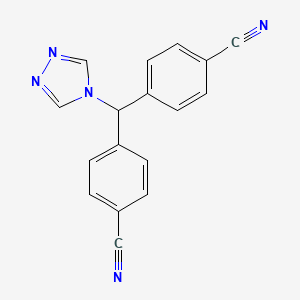

![(2S)-N-[(4S,6S)-4-amino-7-(3-aminopropanoyl)-6-formyl-9-hydroxy-2,11-dimethyl-5,8-dioxo-7-phenyldodecan-6-yl]-2-hydroxy-N,4-dimethylpent-4-enamide](/img/structure/B1674780.png)
![[(3aS,4S,5R,6Z,10Z,11aR)-3a,4-dihydroxy-6,10-dimethyl-3-methylidene-2-oxo-5,8,9,11a-tetrahydro-4H-cyclodeca[b]furan-5-yl] 2-methylpropanoate](/img/structure/B1674782.png)
